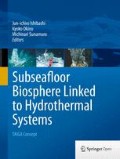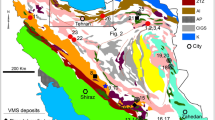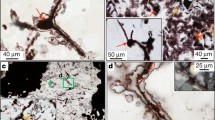Abstract
The Irabu Knoll hydrothermal vents were first discovered in 2000 during YK00-06 cruise using R/V YOKOSUKA and manned submersible SHINKAI 6500. The Irabu Knoll consists of three seamounts from 1,680 to 1,970-m in water depth. The Irabu Knoll is located in the Southern Okinawa Trough and is constructed from basalt as the host rock. Two hydrothermal venting sites have been found at East and West seamount. Sulfide deposit of the Irabu Knoll hydrothermal system consists of barite, sphalerite, pyrite, and chalcopyrite. Major taxa in the vent ecosystem are Shinkaia crosnieri, Munidopsis sp., and Ashinkailepsas sp.
You have full access to this open access chapter, Download chapter PDF
Similar content being viewed by others
Keywords
1 Location and Geological Settings
The Irabu Knoll was first recognized through comprehensive geological and geophysical surveys in 1988 (Oshima et al. 1988; Kimura et al. 1991; Shinjo 1999). It locates at 55 km off the northwest of the Miyako Island on the eastern edge of the Yaeyama Graben in the Southern Okinawa Trough (Fig. 39.1). The Southern Okinawa Trough characterized by an active rifting of the Asian continental margin and the Yaeyama Graben is considered to be a key area to understand tectonics and evolution of back-arc basins. The Irabu Knoll consists of three major seamounts, East, West, and South seamounts. The East seamount has a caldera-like elliptic depression with an opening on its northwest face. The major and minor axis of the depression is ca. 600 and 400 m, respectively. The water depth at the bottom of the depression is 1,970 m. The West seamount has a truncated cone feature and the water depth of the seamount is ca. 1,680 m. The South seamount has been reported as EW-elongated structure by Matsumoto et al. (2001), but the accurate water depth is not determined yet. In 2000, several dives using manned submersible SHINKAI 6500 revealed the existence of hydrothermal activities at the East and the West seamounts, however, no dive has been carried out at the South seamount (Matsumoto et al. 2001). Former two seamounts were composed of fresh basaltic pillow lava, and thin sediments were covered on the pillow lava in the flank of the seamounts (Fig. 39.2a). Hydrothermal vents are located on the south face of the East seamount (25°14.10′N, 124°52.89′E; water depth = 1,876 m) and at the summit of the West seamount (25°13.76′N, 124°52.16′E; water depth = 1,648 m). Sulfide deposits collected from the West seamount are likely to be composed under rather higher sulfidation state and are mineralogically similar to those of the Kuroko deposits rather than the Bessi-type deposits (Watanabe et al. 2006). Existence of indium in the sulfide chimney, revealed using neutron activation analysis (Noguchi 2007), is consistent with geochemical characteristic common on the basaltic lava hosted hydrothermal fields (e.g. the East Pacific Rise and the Southern Mariana Trough). To observe the hydrothermal plumes and to collect the rocks, sulfide minerals, and biological samples for geochronological studies, following three cruises were conducted in 2011 and 2012, NT11-17 (R/V NATSUSHIMA and ROV HYPER-DOLPHIN, JAMSTEC) (Fukuba 2011), NT11-20 scientific cruise in 2011 (R/V NATSUSHIMA and ROV HYPER-DOLPHIN), and YK12-05 (R/V YOKOSUKA and manned submersible SHINKAI 6500, JAMSTEC).
Bathymetry of the Southern Okinawa Trough and location of the hydrothermal vents at the Irabu Knoll. Ws hydrothermal vents on the West seamount, Ns hydrothermal vents on the East seamount, Bc Mytiloidea colonies with weak seepage, Ps Previously reported site (Matsumoto et al. 2001). The South seamount is not shown in the bathymetric map
Pictures of geological and biological feature at the Irabu Knoll. (a) Fresh basaltic pillow lava, (b) Active hydrothermal site at the West seamount, (c) Crustaceans dominated by Shinkaia crosnieri and Munidopsis sp., (d) Dense colony of Ashinkailepsas sp. (e) A small colony of bivalves on the northern inside slope
2 Hydrothermal Activity and Biogeochemical Properties
Clear hydrothermal fluid venting was found at the summit of the West seamount. A grid survey of hydrothermal plume using ROV HYPER-DOLPHIN found the temperature anomalies at three points around the rugged summit of the seamount (Suppl. 39.1). White-fluffy precipitates were observed in hydrothermal plume and covered a part of the massive sulfides and chimney structures. The highest fluid temperature in the Irabu Knoll, 67 °C, was recorded at a clear smoker vent on the West seamount during 2011 survey (Fukuba 2011). Dense and diverse populations of Crustaceans dominated by Shinkaia crosnieri, Munidopsis sp. (Fig. 39.2b–d), and Ashinkailepsas sp. (Fig. 39.2d) were observed around the active chimneys. Hydrothermal chimney structures and sulfide deposits at the East seamount were smaller than those of the West seamount. The chimneys were distributed on flat terraces and cliffs at the south face of the caldera-like depression. Clear hydrothermal fluid was venting from the chimneys and gaps between rocks on cliffs. The other hydrothermal site with seepage was found at northern inside face of the depression. Small colonies of bivalves were interspersed on a rocky slope covered by thin sediment (Fig. 39.2e).
References
Fukuba T (2011) Hydrothermal plume mapping by in situ multi parameter measurements at the Yoron Knoll and the Irabu Knoll, NATSUSHIMA Cruise Report. http://www.godac.jamstec.go.jp/catalog/data/doc_catalog/media/NT10-16_all.pdf
Kimura M, Furukawa M, Izawa E, Ishikawa M, Kuramoto S, Sakai H, Uyeda S, Markris J (1991) Report of DELP 1988 cruises in the Okinawa Trough. Part 7. Geologic investigation of the central rift in the middle to southern Okinawa Trough. Bull Earthq Res Instit Univ Tokyo 66:179–209
Matsumoto T, Kinoshita M, Nakamura M, Sibuet JC, Lee CS, Hsu SK, Oomori T, Shinjyo R, Hashimoto Y, Hosoya S, Imamura M, Ito M, Tsukuda K, Yagi H, Tatekawa K, Kagaya I, Hokakubo S, Okada T, Kimura M (2001) Volcanic and hydrothermal activities and possible “segmentation” of the axial rifting in the westernmost part of the Okinawa Trough. Preliminary results from the YOKOSUKA/SHINKAI 6500 Lequios Cruise. JAMSTEC J Deep Sea Res 19:95–107 (in Japanese with English abstract)
Noguchi T (2007) Geochemical study on the deep and shallow submarine hydrothermal activities, Ph.D. thesis, University of the Ryukyus, Okinawa, Japan
Oshima S, Takanashi M, Kato S, Uchida M, Okazaki I, Kasuga S, Kawashiri C, Kaneko Y, Ogawa M, Kawai K, Seta H, Kato Y (1988) Geological and geophysical survey in the Okinawa Trough and the adjoining seas of Nansei Syoto. Rep Hydr Res 24:19–43 (in Japanese with English abstract)
Shinjo R (1999) Geochemistry of high Mg andesites and the tectonic evolution of the Okinawa Trough—Ryukyu arc system. Chem Geol 157:69–88
Watanabe M, Hoshino K, Shinokawa R, Takaoka Y, Fukumoto H, Shibata Y, Shinjo R, Oomori T (2006) Metallic mineralization associated with pillow basalts in the Yaeyama Central Graben, Southern Okinawa Trough, Japan. JAMSTEC Rep Res Dev 3:1–8
Acknowledgement
Part of the bathymetric data was supplied from Japan Oceanographic Data Center (JODC). This work was partially supported by a Grant-in-Aid for Scientific Research on Innovative Areas (Project TAIGA, no. 20109003).
Author information
Authors and Affiliations
Corresponding author
Editor information
Editors and Affiliations
1 Electronic Supplementary Material
Below is the link to the electronic supplementary material.
317349_1_En_39_MOESM1_ESM.tif
Suppl. Fig. 39.1 Preliminary results of hydrothermal plume observations by ROV HYPER-DOLPHIN during NT11-17 in 2011. Three separated temperature anomalies were found on a 1,626 m-deep survey line. The maximum temperature anomaly was detected just above hydrothermal vents of the West seamount
Rights and permissions
Open Access This chapter is distributed under the terms of the Creative Commons Attribution Noncommercial License, which permits any noncommercial use, distribution, and reproduction in any medium, provided the original author(s) and source are credited.
Copyright information
© 2015 The Author(s)
About this chapter
Cite this chapter
Fukuba, T., Noguchi, T., Fujii, T. (2015). The Irabu Knoll: Hydrothermal Site at the Eastern Edge of the Yaeyama Graben. In: Ishibashi, Ji., Okino, K., Sunamura, M. (eds) Subseafloor Biosphere Linked to Hydrothermal Systems. Springer, Tokyo. https://doi.org/10.1007/978-4-431-54865-2_39
Download citation
DOI: https://doi.org/10.1007/978-4-431-54865-2_39
Published:
Publisher Name: Springer, Tokyo
Print ISBN: 978-4-431-54864-5
Online ISBN: 978-4-431-54865-2
eBook Packages: Earth and Environmental ScienceEarth and Environmental Science (R0)






